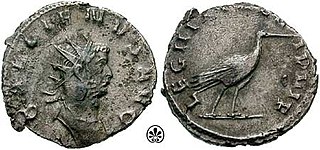
Grannus was a Celtic deity of classical antiquity. He was regularly identified with Apollo as Apollo Grannus and frequently worshipped in conjunction with Sirona, and sometimes with Mars and other deities.

In Celtic polytheism, Sirona was a goddess worshipped predominantly in East Central Gaul and along the Danubian limes. A healing deity, she was associated with healing springs; her attributes were snakes and eggs. She was sometimes depicted with Apollo Grannus or Apollo Borvo. She was particularly worshipped by the Treveri in the Moselle Valley.

Legio III Italica was a legion of the Imperial Roman army founded in 165 AD by the emperor Marcus Aurelius for his campaign against the Marcomanni tribe. The cognomen Italica suggests that the legion's original recruits were drawn for the defence of Italy. The legion was still active in Raetia and other provinces in the early 5th century.
Marcus Statius Priscus Licinius Italicus was a Roman senator and general active during the reigns of Hadrian, Antoninus Pius, and Marcus Aurelius. Contemporary sources refer to him as Marcus Statius Priscus or simply Statius Priscus. He was consul for the year 159 as the colleague of Plautius Quintillus; Priscus was one of only two homines novi to attain the ordinary consul in the reigns of Antoninus Pius and Marcus Aurelius.

The Castra Nova equitum singularium was an ancient Roman fort in Rome housing part of the emperor's cavalry bodyguard. The site of the fort now lies beneath the Basilica of St John Lateran. The Castra Nova, or "new fort", was one of two cavalry forts that provided a base in Rome for the mounted bodyguard of the Roman emperors.

The Castra of Drobeta-Turnu Severin was built by Emperor Traian, in the Roman Dacia province.

Noviodunum, known also as Noviodunum ad Istrum, was a fort and a port in the Roman province of Moesia located on the lower Danube.

The Castra Albana was an ancient Roman legionary fortress of the Legio II Parthica founded by the Emperor Septimius Severus (193-211) on the site of the present Albano Laziale.

A burgus or turris ("tower") is a small, tower-like fort of the Late Antiquity, which was sometimes protected by an outwork and surrounding ditches. Darvill defines it as "a small fortified position or watch-tower usually controlling a main routeway."
The gens Orbia was a minor plebeian family at Rome. No members of this gens are known to have held any magistracies, but many of them are known from inscriptions. The most illustrious of the family may have been the jurist Publius Orbius, a contemporary of Cicero.
The gens Orfidia was a minor plebeian family at Rome. Only a few members of this gens occur in history, but others are mentioned in inscriptions. The most illustrious of the Orfidii was probably Publius Orfidius Senecio, consul suffectus in AD 148.

Cohors prima Flavia Canathenorum [sagittaria] [milliaria] was a Roman auxiliary cohort of infantry.
The gens Pacilia was an obscure plebeian family at ancient Rome. Few members of this gens are mentioned by the ancient historians, of whom the most famous may be a certain Marcus Pacilius spoken of by Cicero in his second oration against Verres. However, many Pacilii are known from inscriptions.
The gens Peducaea, occasionally written Paeducaea or Peducea, was a plebeian family at ancient Rome. Members of this gens occur in history from the end of the second century BC, and from then to the time of Antoninus Pius, they steadily increased in prominence. The first of the Peducaii to obtain the consulship was Titus Peducaeus in 35 BC.

The gens Persia was a minor plebeian family at ancient Rome. Members of this gens are first mentioned during the Second Punic War, but they only occasionally occur in history. The most illustrious of the family was the satirist Aulus Persius Flaccus, who lived during the middle part of the first century.
Marcus Sempronius Liberalis was a Roman eques who held a number of appointments during the reign of the Emperor Marcus Aurelius. He is known from military diplomas and non-literary papyrus.
The gens Tuticana, sometimes written Tuticania, was an obscure plebeian family at ancient Rome. Only a few members of this gens are mentioned in history, but a number are known from inscriptions.
This page is based on this
Wikipedia article Text is available under the
CC BY-SA 4.0 license; additional terms may apply.
Images, videos and audio are available under their respective licenses.











